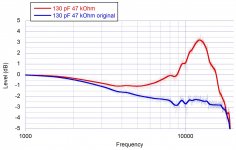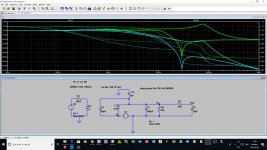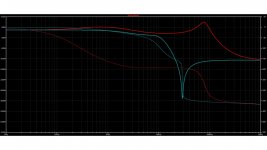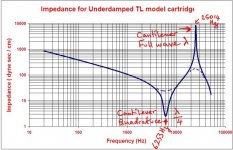I'm not sure anyone knows*! We never got many hints of inband cantilever resonances when we went looking for them other than the most Clydesdale** of cantilevers. As LD says so many loose ends to tug. I think we are closer now than before though.
*well people did know, they just never told and the knowledge is dying with them.
**A popular breed of heavy horse. weighs 800-1000kg
*well people did know, they just never told and the knowledge is dying with them.
**A popular breed of heavy horse. weighs 800-1000kg
I think that, for all the wrong reasons, cartridges with low effective tip mass don't have audioband resonances.We never got many hints of inband cantilever resonances when we went looking for them
Tip mass was worked backwards from observation of the 'top resonance' assuming a certain vinyl spring constant, which value I've lost and can't find again. Now whether that is right or wrong I suppose is a moot point: what matters is that the resonance is clear of the audioband. Tip mass is a restatement of that.
LD
Thank you Dilbert.
Has the Canadian assignee “Amber electro design” put in the market any such preamplifier since 1985. ?
I looked and didn't find any reference.
George
Has the Canadian assignee “Amber electro design” put in the market any such preamplifier since 1985. ?
I looked and didn't find any reference.
George
A Good find. Ed Meitner. Not suprised really. Nothing in his current lineup has that, but he's been a digital guy for years (decades?). I'll try and find an interview he did and see if he mentions it there.
Not ever produced or sold by Amber, but Ed Meitner later moved to the now defunct Museatex, preamps were sold under under the Meitner name, I seem to remember.
Amber strictly made audio test gear.
Amber strictly made audio test gear.
Last edited:
According to Meitner PA6i they sold a transimpedance MC module but not MM. I guess like most he realised it was too hard to setup for the average user.
Museatex Melior Phono Center says it's a trans amp but the setup instructions don't suggest that
Museatex Melior Phono Center says it's a trans amp but the setup instructions don't suggest that
Yes, R Comp needs to be selected based on the specific MM cartridge inductance and DCR. Not consumer friendly, for sure. I think the PA6 did offer it initially for MM cartridges, but it was likely dropped.
It had plug in phono card options.
It had plug in phono card options.
Last edited:
There's nothing in the patent that helps us further.
It's in the same category as the Aurak with the virtual gnd input.
Hans
It's in the same category as the Aurak with the virtual gnd input.
Hans
Nothing that hasn't been rediscovered no, but still interesting to note that this idea has been seriously considered 30+ years ago.
Nothing that hasn't been rediscovered no, but still interesting to note that this idea has been seriously considered 30+ years ago.
+1
There's nothing in the patent that helps us further.
It's in the same category as the Aurak with the virtual gnd input.
Hans
Hey Hans, I only shared as an FYI. With all due respect, I bet you’re really fun at a party.
Actually I'm the one who's no fun at parties!
I will say that, for me, for whom these things are not always obvious seeing how he got the 50Hz pole was interesting. Same topology, two approaches. But there is something that feels right about getting the pole there and needing less correction downstream. I can't tell what is lost this way over the 2L-R approach without thinking about it.
I will say that, for me, for whom these things are not always obvious seeing how he got the 50Hz pole was interesting. Same topology, two approaches. But there is something that feels right about getting the pole there and needing less correction downstream. I can't tell what is lost this way over the 2L-R approach without thinking about it.
I'm not sure anyone knows*! We never got many hints of inband cantilever resonances when we went looking for them other than the most Clydesdale** of cantilevers.
Maybe so, if one simulates the three loadings, 100pF||47k, open circuit, short circuit the coil currents are orders of magnitude different. Should this not show up some how in the magnitude of eddy current effects?
I mis-spoke a little yesterday, what I meant was that the midrange dip has a 1-3dB per decade slope which is (small) fractional f and I don't see modeling it except with some broad distributed time constant mechanism. So I didn't mean cantilever resonance per se but something else mechanical possibly.
EDIT - I might be in the wrong thread. 🙂
EDIT - I might be in the wrong thread. 🙂
Last edited:
I've had another bash at this. I've 'modelled' the mechanical resonance with V2 which gives deep dip at 30 kHz - obviously this can be moved around within reason with the judicious adjustment of parasitic L and C.
I can only get a significant resonant peak at ~20 kHz if I increase the cart load from 47k to 100-200k which hardly representative of reality. More work needed.
R3 and C2 crudely model the RIAA corner f at 2120Hz.
I need to find a way to sum to two curves. Anyway, my 2 cents worth.
Keantoken, where are you? 😀
I can only get a significant resonant peak at ~20 kHz if I increase the cart load from 47k to 100-200k which hardly representative of reality. More work needed.
R3 and C2 crudely model the RIAA corner f at 2120Hz.
I need to find a way to sum to two curves. Anyway, my 2 cents worth.
Keantoken, where are you? 😀
Attachments
Yup, it's still a mind melt to work out which thread applies 😉I mis-spoke a little yesterday, what I meant was that the midrange dip has a 1-3dB per decade slope which is (small) fractional f and I don't see modeling it except with some broad distributed time constant mechanism. So I didn't mean cantilever resonance per se but something else mechanical possibly.
EDIT - I might be in the wrong thread. 🙂
Bending mechanics and wave propagation theory yields equations in fractional powers in fourths.
Here's a plot from a while back on calculated cantilever impedance as seen from the pointy end which sort of has an interesting and familiar profile. Only certain modes of cantilever bending resonance are permissible without mistracking.
Cantilevers bend!
LD
Attachments
- Status
- Not open for further replies.
- Home
- Source & Line
- Analogue Source
- Phono cartridge self resonance



